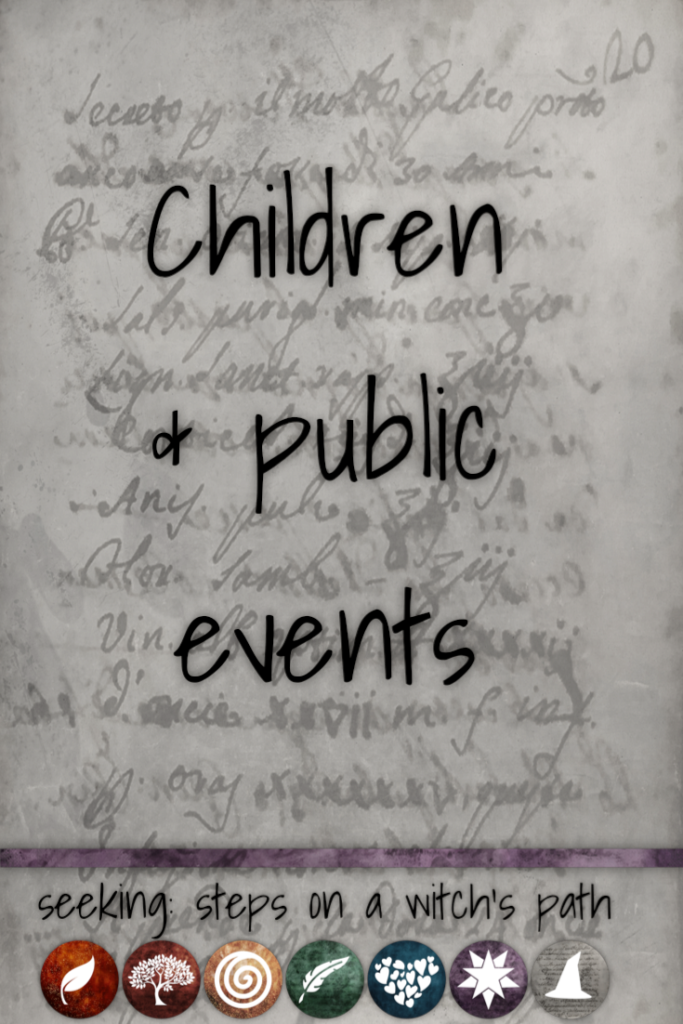One common question is about bringing children to public events. Here, you’re really going to have to look at the specifics – both of your child/children and of the event.

Learn about the event:
Generally, public rituals and events will make it pretty clear whether children are welcome, and if childcare is provided.
Some rituals welcome and include children in the ritual, some provide child care, some allow children above a certain age, some allow children who can follow a basic adult level of behavior (i.e. staying quiet during a longer meditation period, being able to deal with somewhat more intense emotions.)
Some groups don’t allow kids – usually because they’re following a path that requires particular commitments, focus, and training that aren’t appropriate to expect of kids or teens.
Groups may also vary across different rituals: Samhain (a time of grieving and memory of the dead) is a hard ritual to make child-appropriate without removing elements that can be very powerful and healing to grieving adults.
Yule, on the other hand, can be a great time to include children in the returning light and sharing of community hearth and tradition.
Think about your child:
How does your child do in new settings?
Public rituals combine a lot of new people with a new setting with different kinds of energy and interaction. That’s a lot of new stuff, even for adults. You might want to go to a couple of public rituals by yourself first so you can prepare your child/ren, know what to expect, and be able to explain things and answer questions.
You could also try similar activities to those likely to be in a ritual you want to attend at home. You won’t duplicate the full effect of being in a group, but you can help your child prepare and get an idea of whether going to a public ritual is a good idea.
Think about the ritual:
Will the ritual include a meditation or period of extended quiet?
How does your child deal with this? Will they sit quietly, or will they rustle around, move, talk in ways that interfere with others, etc.
(A good guide might be whether they can sit quietly reading a book or amusing themselves silently for 20 minutes in other settings – not watching a movie or talking to you.)
Do you feel you can keep an eye on your child, while getting what you need out of the experience?
Pagan rituals are great places, but they do have some possible risks. Some rituals include a bonfire. Others use sharp blades for part of the ritual work, or other things that might hurt a small child running around and not aware of the risks.
It’s important that you feel you can keep your child near you, or under close supervision at all times. Don’t expect others to watch your child for you, unless they’ve specifically agreed.
Think about other people participating:
Remember that others are there to enjoy and get things out of the ritual too.
That doesn’t mean your child has to be silent – especially if children are part of the ritual. But it does mean you should be thoughtful about whether your child can generally participate or whether they will be a distraction to everyone around you.
(One of the problems of having fewer rituals in a year is that if a very unhappy child screams all through a Sabbat, you’ve got a 6 or 7 week wait for the next one – not “Oh, I’ll come to services again on Sunday”).
Be extra sure you know how to excuse yourself from the ritual circle if something does come up you can’t resolve quickly.
You might try bringing your child to a ritual which is less emotionally weighted or more child-appropriate first, and then try other rituals if that goes well. Samhain tends to be a quieter and more introspective, while some summer rituals are often more energetic.

Last edited December 26, 2016. Reformatted November 2020.



